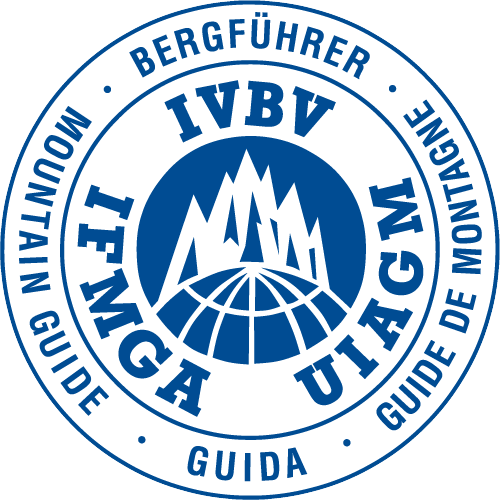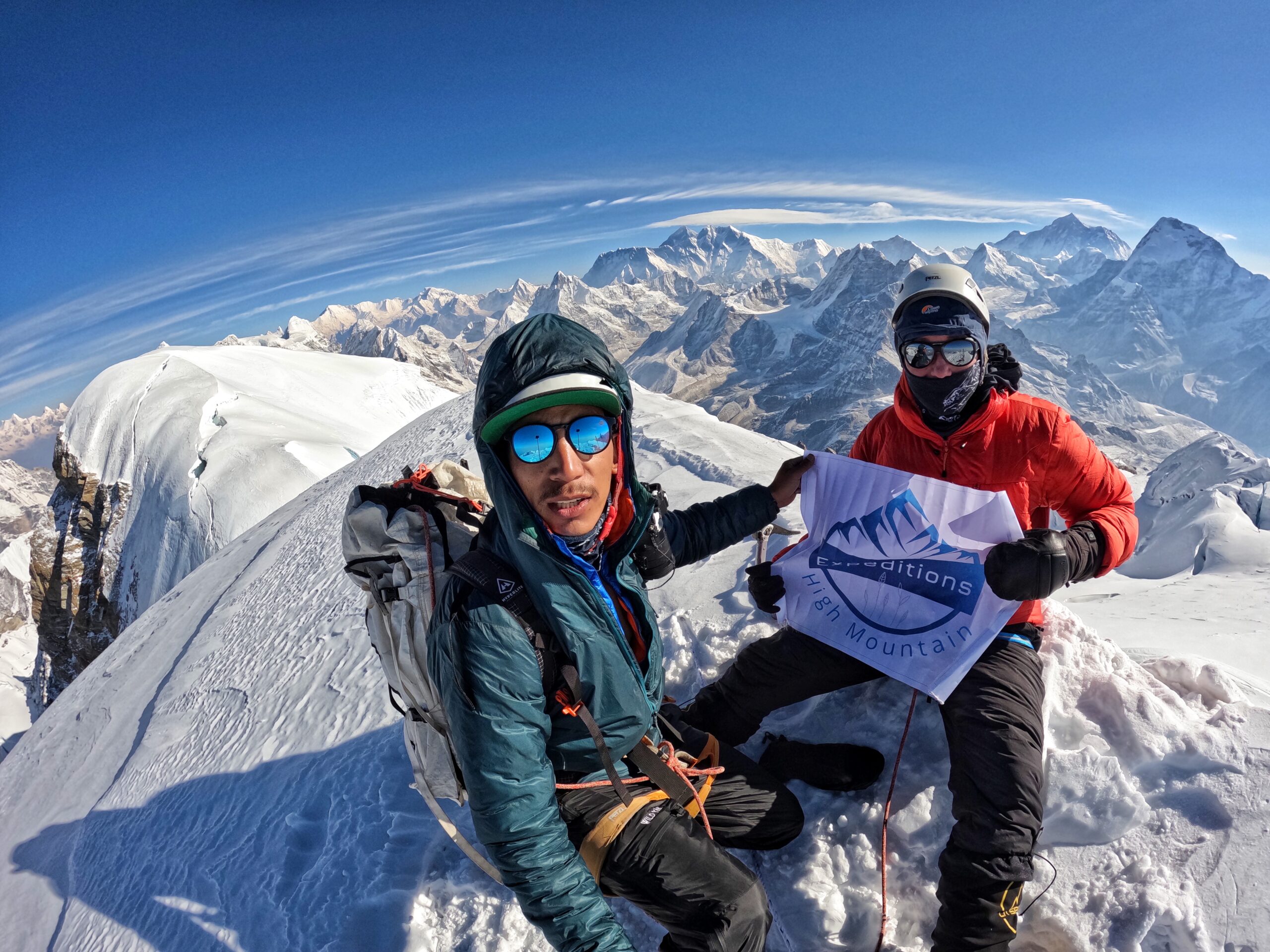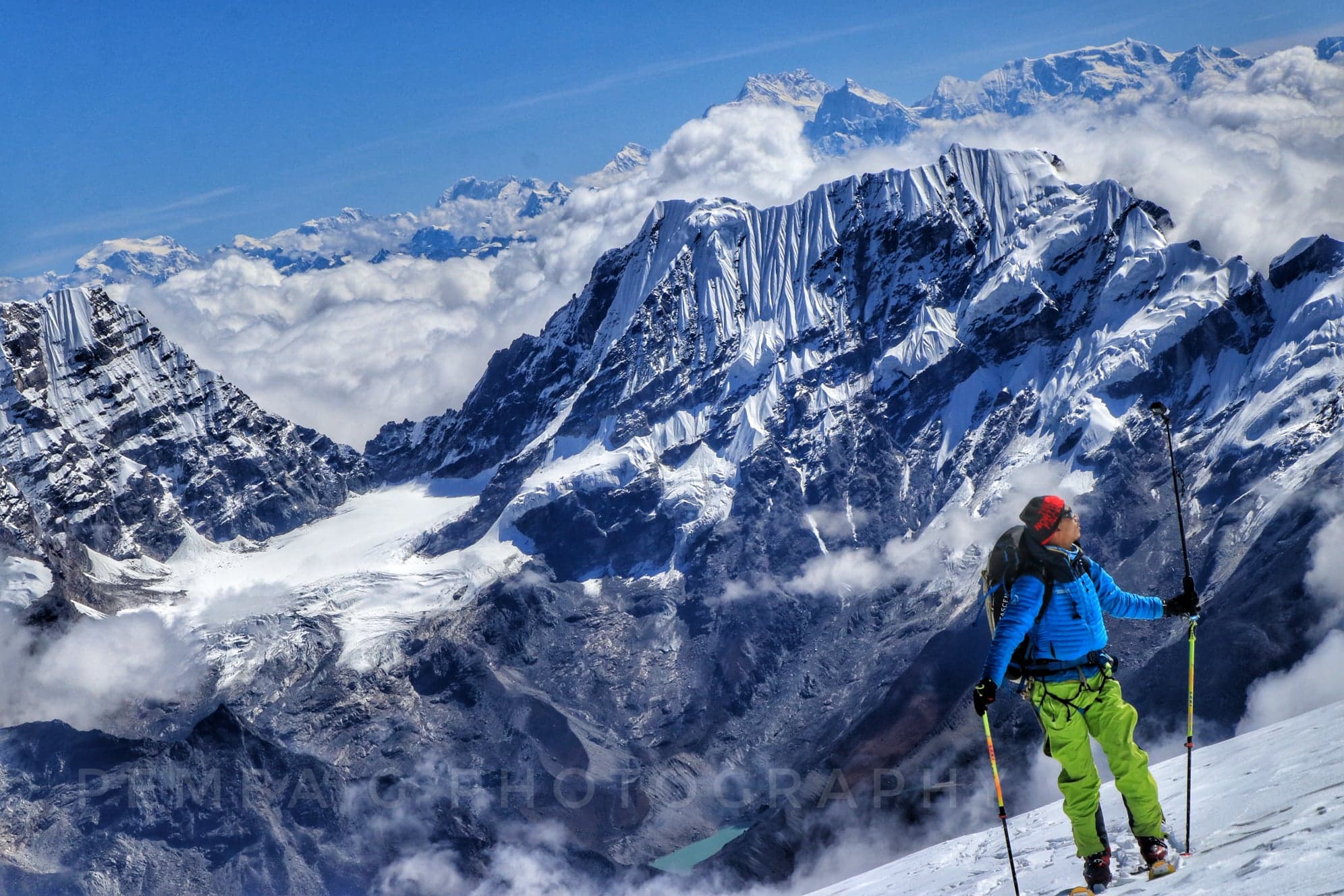

Our team is here to support you 24/7. Please feel free to provide your queries. You will get response within few minutes.

$ 4,000 with the IFMGA Guide
$ 3,000 without the IFMGA Guide



Mera Peak, 6476m, is the highest permitted trekking peak in Nepal as per NMA(Nepal Mountaineering Association) but technically an easy climb compared to other 6000m trekking peaks in Nepal. Therefore, an excellent peak for those looking for thier first climbing experience in the Himalaya of Nepal. The 6476m altitude do cover up for the technical differences hence good preparations, physically and mentally is required. The other main reason people opt to climb Mera Peak is the magnificent summit view of the over-8000-meter-mountains such as Mt. Everest, 8848m, Mt. Lhotse, 8516m, Mt. Cho Oyu, 8201m, Mt. Makalu, 8463m, and Mt. Kanchenjunga, 8586m.
Mera Peak Climbing trip starts with a flight from Kathmandu to Lukla. The trek leads through the incredibly remote and beautiful Hinku Valley. This unspoiled area of the Everest region boasts of beautiful green terraced fields, dense forest, rushing streams, swinging bridges, and yak pastures with a backdrop of the highest mountains in the world. Sherpa guesthouses, high in the summer pastures, are a welcome place for weary trekkers.
Previous climbing experience on snow and ice would be a great advantage, additionaly our well-experienced Sherpa climbing guides will organize a training session on the climbing gear and necessary skills required for the climb.This is a straightforward climb for which acclimatization is crucial. As you trek higher into this remote valley, following the river to the glaciers, your body is gradually becoming acclimatized for the climb. Khare village 4,950m is the last village on the Mera Peak trail where we will have Tea Houses. We have a mandatory acclamatization day, basic climbing clinic program and checking our gears and equipments before we move to mountain. We will set High Camp 5780m before attempting for the final summit push.
Our climbing guides are dedicated mountaineers and license-holders who always put your safety first. They use harness and ropes below the every peak whether for crevasse danger or steep slopes. Our Sherpa guides are there to fix the rope as well as teach climbers how to fix the rope or set up a belay for glacier travel.
Safety for Mera Peak Climb:
When travelling in remote mountain regions, uncertainties such as weather, health problems and natural disasters require a certain amount of flexibility. While our goal is to follow the itinerary, that is not our first priority; your safety is always our first priority. Expeditions high mountain. request your cooperation to accept the decisions and advice of our trusted and experienced guides if they deem it necessary to change or cancel any part of the itinerary due to safety concerns.
We should also plan for few extra days as bad weather may affect the designed schedule. This doesnt guarantee the successful ascent but often avoids the disappointment of a cloudy summit day.
Travel Insurance:
You will need special travel insurance for participation in hazardous activities. We recommend a complete travel insurance policy that covers cancellation, lost baggage, theft, injury, liability, medical treatment, death and expenses. Make sure the insurance covers all the activities that you will be undertaking during your stay in Nepal including trekking and climbing.
Remark: – Please note that cloud and turbulent weather is a regular phenomenon in the Himalayan range. It is thus possible that domestic flights from Kathmandu to/from Lukla may be delayed for a few hours or even canceled for a day or more. Fortunately, this does not happen frequently during the high seasons of March to May or September to November: but you need to plan for this possibility.
As a safeguard, we recommend that you add on a couple of extra days after your trek before you fly from Kathmandu to your onward destination.

17 Days Trekking / Peak Climbing / (SKILL LEVEL: hard)
Remark: – Please note that cloud and turbulent weather is a regular phenomenon in the Himalayan range. It is thus possible that domestic flights from Kathmandu to/from Lukla may be delayed for a few hours or even canceled for a day or more. Fortunately, this does not happen frequently during the high seasons of March to May or September to November: but you need to plan for this possibility.
As a safeguard, we recommend that you add on a couple of extra days after your trek before you fly from Kathmandu to your onward destination.
Day 1: Arrival in Kathmandu and Transfer to Hotel
Upon your arrival in Kathmandu, our representative from Expeditions High Mountain Treks will greet you at Tribhuvan International Airport and transfer you to your hotel. Kathmandu, the vibrant capital of Nepal, offers a blend of ancient culture and bustling modernity. After checking into your hotel, you can relax and recover from your journey. In the evening, you will have a briefing session about the trek, where you will meet your guide and fellow trekkers. This is followed by a welcome dinner at a traditional Nepali restaurant, providing a perfect start to your adventure.
Day 2: Flight to Phaplu and Drive to Kharikhola
We begin the day with a scenic 30-minute flight from Kathmandu to Phaplu Airport, offering stunning views of the Himalayan ranges. Upon arrival in Phaplu, we will start a 5-hour drive to Kharikhola. The drive takes us through picturesque landscapes, terraced fields, and charming villages. Kharikhola is a beautiful village that provides a glimpse into the local culture and lifestyle. After arriving, we settle into our accommodations and prepare for the trekking journey ahead.
Day 3: Drive to Sipoje via Pangum La Pass and Trek to Ramailo Dada (3,100m)
After breakfast, we take a 1-hour drive to Sipoje via the Pangum La Pass, which offers panoramic views of the surrounding peaks. From Sipoje, we start our trek towards Ramailo Dada. The trail meanders through lush forests, rhododendron groves, and scenic landscapes. The climb is gradual, allowing us to acclimate while enjoying the natural beauty. Ramailo Dada, perched at an elevation of 3,100 meters, provides a serene setting for our overnight stay.
Day 4: Trek to Chattra Khola (2,600m)
Today, we trek from Ramailo Dada to Chattra Khola. The trail descends through dense forests and picturesque valleys, crossing several streams and suspension bridges. We pass through remote villages where we can observe the traditional lifestyle of the local people. The trek is moderately challenging but rewarding, with opportunities to spot wildlife and enjoy the tranquility of the Himalayan foothills. Chattra Khola, situated at 2,600 meters, is a peaceful spot for our night’s rest.
Day 5: Trek to Kote (3,800m)
Our journey continues as we trek from Chattra Khola to Kote. The trail gradually ascends through forested areas and alpine meadows, offering stunning views of snow-capped peaks. As we gain altitude, the landscape changes, with fewer trees and more open vistas. We pass through the Hinku Valley, a region known for its dramatic scenery and remote beauty. Kote, located at 3,800 meters, serves as our base for the night, providing stunning views and a sense of accomplishment.
Day 6: Trek to Tangnag (4,200m)
Today’s trek takes us from Kote to Tangnag, gradually ascending to higher altitudes. The trail follows the Hinku River, surrounded by towering peaks and glacial moraines. As we approach Tangnag, the valley opens up, revealing expansive views of the surrounding mountains. Tangnag, at 4,200 meters, is a small settlement with basic amenities. The increased altitude requires us to pace ourselves and stay hydrated. This is an important day for acclimatization as we prepare for the higher altitudes ahead.
Day 7: Rest Day and Hike to 5,500m
We spend the day in Tangnag for acclimatization, which is crucial for our bodies to adjust to the high altitude. A hike up to 5,500 meters is planned to aid acclimatization and improve our chances of success on the summit day. This hike offers breathtaking views of Mera Peak and other surrounding mountains. The day is designed to be flexible, allowing ample time for rest and exploration. Returning to Tangnag, we rest and prepare for the next stage of our trek.
Day 8: Trek to Khare (5,000m)
Our trek continues from Tangnag to Khare, ascending to an elevation of 5,000 meters. The trail is challenging, with steep sections and rocky terrain. As we gain altitude, the air becomes thinner, and the landscape more rugged. Khare is the base camp for Mera Peak, offering spectacular views of the surrounding peaks. This stage of the trek is crucial for acclimatization and preparation for the summit attempt. We settle into our lodge and prepare for the days ahead.
Day 9: Rest Day and Hike to 5,500m
Another rest day in Khare allows us to acclimate further. We take a hike to an elevation of 5,500 meters, providing additional acclimatization and stunning views. The hike is an important part of our preparation, ensuring that our bodies are ready for the higher altitudes of the summit attempt. The rest day also offers an opportunity to check our gear, rest, and mentally prepare for the ascent to Mera Peak. Returning to Khare, we rest and prepare for the high camp.
Day 10: Trek to High Camp (5,800m)
Today, we trek from Khare to Mera High Camp, situated at 5,800 meters. The trail is steep and challenging, with sections of snow and ice. As we ascend, the air becomes noticeably thinner, requiring slow and steady progress. High Camp offers breathtaking views of some of the highest peaks in the world, including Everest, Lhotse, and Makalu. This stage is crucial for acclimatization and final preparations for the summit push. We set up camp and rested early, anticipating the early start for the summit attempt.
Day 11: Summit Mera Peak (6,470m) and Descend to Khare
Summit day begins early, with a pre-dawn start to take advantage of favorable weather conditions. The climb to Mera Peak’s summit at 6,470 meters is demanding but immensely rewarding. The ascent involves crossing glaciers and navigating steep sections. Reaching the summit, we are rewarded with panoramic views of the surrounding Himalayan giants. After spending some time on the summit, we begin our descent back to Khare. The descent is challenging but the sense of accomplishment and stunning views keep us motivated.
Day 12: Trek to Kote
We retrace our steps from Khare to Kote, descending through the Hinku Valley. The descent is easier on the lungs but still requires careful navigation. The scenery, which we first encountered on the ascent, offers a different perspective on the return journey. We pass through familiar landscapes, enjoying the changing views as we lose altitude. Arriving in Kote, we rest and reflect on the successful summit of Mera Peak.
Day 13: Trek to Chattra
Continuing our descent, we trek from Kote to Chattra. The trail takes us through lush forests and along the banks of the Hinku River. The lower altitude and gradual descent provide a welcome relief after the challenging days at higher elevations. The trek is scenic and enjoyable, with opportunities to spot wildlife and enjoy the natural beauty of the region. Chattra, a tranquil spot, provides a comfortable resting place for the night.
Day 14: Trek to Lukla via Chattra La Pass (4,600m)
Today, we trek from Chattra to Lukla via the Chattra La Pass. The pass, at an elevation of 4,600 meters, offers stunning views of the surrounding peaks and valleys. The trail is challenging, with steep ascents and descents, but the breathtaking scenery makes it worthwhile. Arriving in Lukla, we celebrate the completion of our trek with a farewell dinner. This final trekking day marks the end of an incredible journey through the Everest region.
Day 15: Fly Lukla to Kathmandu
We take an early morning flight from Lukla to Kathmandu, offering one last aerial view of the Himalayas. Upon arrival in Kathmandu, we transfer to our hotel and have the rest of the day to relax or explore the city. You can visit local markets, buy souvenirs, or simply rest after the strenuous trek. In the evening, we gather for a farewell dinner, celebrating our achievements and sharing stories from the trek.
Day 16: Extra Day (In Case of Bad Weather)
This extra day is reserved in case of delays due to bad weather. It ensures that we have sufficient time to complete the trek and return to Kathmandu safely. If everything goes as planned, this day can be spent exploring Kathmandu, visiting cultural sites, or shopping for souvenirs.
Day 17: Final Departure
After breakfast, we will transfer you to Tribhuvan International Airport for your final departure. This marks the end of your incredible journey through the Everest region and the successful summit of Mera Peak. We hope you have enjoyed the trek and carry unforgettable memories of the majestic Himalayas. Thank you for choosing our service, and we wish you a safe journey home. We look forward to welcoming you on another adventure in the future.
Expedition High Mountains suggests the following list of gear and equipment to have for the Mera Peak expedition:
Liner gloves
Fleece gloves
Expedition Gore-Tex gloves (heavy duty)
Mittens